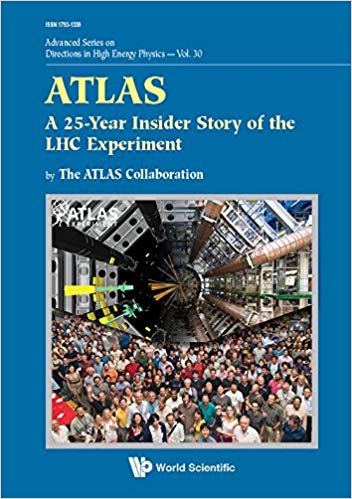ATLAS – A 25 Year Insider Story of the LHC Experiment, by the ATLAS Collaboration, World Scientific

ATLAS – A 25 Year Insider Story of the LHC Experiment is a comprehensive overview of one of the most complex and successful scientific endeavours ever undertaken. 117 authors collaborated to write on diverse aspects of the ATLAS project, ranging from the early days of the proto-collaboration, to the test-beam studies to verify detector concepts, the design, building and installation of the detector systems, building the event selection and computing environment required, forming the organisation, and finally summarising the harvest of physics gathered thus far. Some of the chapters cover topics that are discussed elsewhere – the description of the detector summarises more extensive journal publications, the major physics achievements have been covered in recent review articles and the organisational structure is discussed on the web – but this volume usefully brings these various aspects together in a single place with a unified treatment.
Despite the many authors who contributed to this book, the style and level of treatment is reasonably coherent. There are many figures and pictures that augment the text. Those showing detector elements that are now buried out of sight are important complements to the text descriptions: the pictures of circuit boards are less helpful, besides demonstrating that these electronics exist. A most engaging feature is the inclusion of one-page “stories” at the ends of the chapters, each giving some insight into the ups and downs of how the enterprise works. Among these vignettes we have such stories as the ATLAS collaboration week that almost no one attended and the spirit of camaraderie among the experimenters and accelerator operators at the daily 08:30 run meetings.
One could imagine several audiences for this book, and I suspect that, apart from ATLAS collaborators themselves, each reader will find different chapters most suited to their interests. The 26-page chapter “The ATLAS Detector Today” offers a more accessible overview for students just joining the collaboration than the 300-page journal publication referenced in most ATLAS publications. Similarly, “Towards the High-Luminosity LHC” gives a helpful brief introduction to the planned upgrades. “Building up the Collaboration” will be useful to historians of science seeking to understand how scientists, institutions and funding agencies engage in a project whose time is ripe. Those interested in project management will find “Detector Construction Around the World” illuminating: this chapter shows how the design and fabrication of detector subsystems is organised with several, often geographically disparate, institutions joining together, each contributing according to its unique talents. “From the LoI to the Detector Construction” and “Installation of the Detectors and Technical Coordination” will appeal to engineers and technical managers. The chapters “Towards the ATLAS Letter of Intent” and “From Test Beams to First Physics” catalogue the steps that were necessary to realise the collaboration and experiment, but whose details are primarily interesting to those who lived through those epochs. Finally, “Highlights of Physics Results (2010 – 2018)” could have offered an exciting story for non-scientists, and indeed the thrill of the chase for the Higgs boson comes through vividly, but with unexplained mentions of leptons, loops and quantum corrections, the treatment is at a more technical level than would be ideal for such readers, and the plots plucked from publications are not best suited to convey what was learned to non-physicists.
What makes a collaboration like this tick?
Given the words in the foreword that the book is “intended to provide an insider story covering all aspects of this global science project,” I looked forward to the final chapter, “ATLAS Collaboration: Life and its Place in Society”, to get a sense of the human dimensions of the collaboration. While some of that discussion is quite interesting – the collaboration’s demographics and the various outreach activities undertaken to engage the public – there is a missing element that I would have appreciated: what makes a collaboration like this tick? How did the large personalities involved manage to come to common decisions and compromises on the detector designs? How do physicists from nations and cultures that are at odds with each other on the world stage manage to work together constructively? How does one account for the distinct personalities that each large scientific collaboration acquires? Why does every eligible author sign all ATLAS papers, rather than just those who did the reported analysis? How does the politics for choosing the collaboration management work? Were there design choices that came to be regretted in the light of subsequent experience? In addition to the numerous successes, were there failures? Although I recognise that discussing these more intimate details runs counter to the spirit of such large collaborations, in which one seeks to damp out as much internal conflict as possible, examining some of them would have made for a more compelling book for the non-specialist.
The authors should be commended for writing a book unlike any other I know of. It brings together a factual account of all aspects of ATLAS’s first 25 years. Perhaps as time passes and the participants mellow, the companion story of the how, in addition to the what and where, will also be written.







